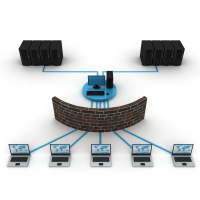How many businesses do you think have a website? 75, 80 percent? It’s 2011, everything’s online, so of course most businesses are going to be online too, right? Wrong.
Only 45 percent of small business owners have a website, according to a recent study by Discover. And while that was a significant increase from the 37 percent in 2009, there are still a significant portion of the driving force of our economy that aren’t cashing in on all the potential the Web can offer.

Still, if you’re in the majority of small businesses that have a website, it’s likely the bloodline of your business. You depend on it to work because without it, your business wouldn’t work. Shopping carts will be left empty. Credit cards won’t get run. Employees can’t work. Customers get frustrated. With competition being just a click away, when your customers can’t do something on your website, they easily click the back button and move on.
Network outages cost businesses an average $1.7 billion each year, according to a recent survey from CDW, so to prevent these things from happening, you need to make sure that your website and critical applications are as healthy as possible. Plus, think of it as a great marketing tool. For an ecommerce site or site that sells third-party products, showing that you had 99% uptime is a huge selling point. Same thing if you have advertising spots on your website. Customers are also more inclined to do business with you because it shows that you take customer service and experience extremely seriously.
Due to a lack of in-house IT staff who can offer 24×7 service, some small business owners have to shoulder this weight themselves. While monitoring it yourself may seem easier at first glance, it takes a lot of man power. You’ll be tethered to a computer or cell phone, constantly monitoring their business’ networks and connectivity at all hours of the day — and night. There are some open source and freeware server/network monitoring tools that can take some of the weight off, but they’re just there for aid. Six Revisions posted a great list of free tools such as Monit, Ganglia, and Munin that can be used as a starting point for your research. Each provided different functionality, so be sure to find one that offers services based off of your needs.
Still, while these tools are a great aid, you get what you pay for, and the free open-source software monitoring won’t come with the support that an outsourced provider does for you. Outsourcing this responsibility frees up man power that can be directed toward running the business. This service also ensures the business does not suffer from downtime or outages due to server crashes or connectivity problems.
Enlisting a monitoring service, like iGLASS Networks that offers 24×7 Web server monitoring services, offers the benefits of reduced downtime as the monitoring service can intercept bugs or issues and alert key personnel before they escalate into major problems. Monitoring providers not only monitor basic functionality, but things like DNS blacklisting, SMTP email servers, VoIP services and ensuring streaming content is readily available. They combat issues that could potentially interrupt service and cause a loss of time, resources or both especially critical for e-commerce.
Relying on such a service is not only proactive, but it eliminates the need to craft your own monitoring solution as many offer customizable services. Service providers handle all software, hardware and personnel needs increasing your business’ productivity while creating peace of mind.
